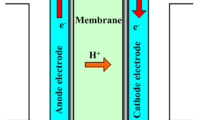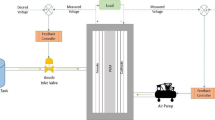Abstract
Proton exchange membrane fuel cell (PEMFC) is an environmentally friendly technology that eliminates the pollution caused by burning fossil fuels. Minimizing power consumption through the air-feed systems of PEMFCs and maximizing the net power output have led to the most optimal control results. Hence, the present paper is conducted to control these parameters optimally. Most previous works used linear models of PEMFC to deal with control problems. Linear models cannot precisely model the nonlinear behavior of the PEMFC stacks. Accordingly, the open-loop nonlinear system is presented as state-dependent polynomial equations, and the state feedback method is employed to design the controller. Furthermore, semi-definite programming based on the sum of square relaxation is used to solve the state-dependent polynomial nonlinear model numerically. On the other hand, due to the high response time of sum of square relaxation (SOS)-based control design methods, the feasibility problem of the SOS-based technique is conceived as an optimization problem to decrease the response time. The most important advantage of the proposed method is that this method guarantees stability. A comparison is also made between the results obtained in this study and the results of one of the most valuable studies. Accordingly, the proposed method could outperform its competitor in the accuracy and efficiency.













Similar content being viewed by others
Data availability
The datasets generated during the current study are not publicly available but are available from the corresponding author.
References
Han, Y., Lai, C., Li, J., Zhang, Z., Zhang, H., Hou, S., et al.: Elastocaloric cooler for waste heat recovery from proton exchange membrane fuel cells. Energy 238, 121789 (2022)
Anyanwu, I.S., Xie, X., Liu, Z., Jiao, K.: Experimental investigation and optimization of proton exchange membrane fuel cell using different flow fields. Energy 217, 119313 (2021)
Ahmadi, S., Ghaebi, H., Shokri, A.: A comprehensive thermodynamic analysis of a novel CHP system based on SOFC and APC cycles. Energy 186, 115899 (2019). https://doi.org/10.1016/j.energy.2019.115899
Zhang, G., Yuan, H., Wang, Y., Jiao, K.: Three-dimensional simulation of a new cooling strategy for proton exchange membrane fuel cell stack using a non-isothermal multiphase model. Appl. Energy 255, 113865 (2019)
Ashrafi, M., Shams, M.: The effects of flow-field orientation on water management in PEM fuel cells with serpentine channels. Appl. Energy 208, 1083–1096 (2017)
Pukrushpan, J.T., Stefanopoulou, A.G., Peng, H.: Control of Fuel Cell Power Systems: Principles, Modeling, Analysis and Feedback Design. Springer Science & Business Media, Berlin (2004)
Laghrouche, S., Harmouche, M., Ahmed, F.S., Chitour, Y.: Control of PEMFC air-feed system using Lyapunov-based robust and adaptive higher order sliding mode control. IEEE Trans. Control Syst. Technol. 23, 1594–1601 (2014)
Zeng, G.-Q., Xie, X.-Q., Chen, M.-R., Weng, J.: Adaptive population extremal optimization-based PID neural network for multivariable nonlinear control systems. Swarm Evol. Comput. 44, 320–334 (2019)
Jia, Z., Yu, J., Mei, Y., Chen, Y., Shen, Y., Ai, X.: Integral backstepping sliding mode control for quadrotor helicopter under external uncertain disturbances. Aerosp. Sci. Technol. 68, 299–307 (2017)
Liaqat, K., Rehman, Z., Ahmad, I.: Nonlinear controllers for fuel cell, photovoltaic cell and battery based hybrid energy management system. J. Energy Storage 32, 101796 (2020)
Li, Y., Zhao, D., Chen, Y., Podlubny, I., Zhang, C.: Finite energy Lyapunov function candidate for fractional order general nonlinear systems. Commun. Nonlinear Sci. Numer. Simul. 78, 104886 (2019)
Shahri, E.S.A., Alfi, A., Machado, J.A.T.: Lyapunov method for the stability analysis of uncertain fractional-order systems under input saturation. Appl. Math. Model. 81, 663–672 (2020)
Li, A., Sun, J.: Stability of nonlinear system under distributed Lyapunov-based economic model predictive control with time-delay. ISA Trans. 99, 148–153 (2020)
Rakhshan, M., Vafamand, N., Shasadeghi, M., Dabbaghjamanesh, M., Moeini, A.: Design of networked polynomial control systems with random delays: sum of squares approach. Int. J. Autom. Control 10, 73–86 (2016)
Yang, D., Pan, R., Wang, Y., Chen, Z.: Modeling and control of PEMFC air supply system based on TS fuzzy theory and predictive control. Energy 188, 116078 (2019)
Deng, H., Li, Q., Cui, Y., Zhu, Y., Chen, W.: Nonlinear controller design based on cascade adaptive sliding mode control for PEM fuel cell air supply systems. Int. J. Hydrog. Energy 44, 19357–19369 (2019)
Aylward, E.M., Parrilo, P.A., Slotine, J.J.E.: Stability and robustness analysis of nonlinear systems via contraction metrics and SOS programming. Automatica 44, 2163–2170 (2008)
Ataei, A., Wang, Q.: Non-linear control of an uncertain hypersonic aircraft model using robust sum-of-squares method. IET Control Theory Appl. 6, 203–215 (2012)
Khodadadi, L., Samadi, B., Khaloozadeh, H.: Estimation of region of attraction for polynomial nonlinear systems: a numerical method. ISA Trans. 53, 25–32 (2014)
Zečević, A.I., Šiljak, D.D.: Estimating the region of attraction for large-scale systems with uncertainties. Automatica 46, 445–451 (2010)
Pozo, F., Rodellar, J.: Robust stabilisation of polynomial systems with uncertain parameters. Int. J. Syst. Sci. 41, 575–584 (2010)
Martins, L., Varela, M.L.R., Fernandes, N.O., Carmo-Silva, S., Machado, J.: Literature review on autonomous production control methods. Enterp. Inf. Syst. 14, 1219–1231 (2020)
Josz, C., Maeght, J., Panciatici, P., Gilbert, J.C.: Application of the moment-SOS approach to global optimization of the OPF problem. IEEE Trans. Power Syst. 30, 463–470 (2014)
Sanchez, T., Cruz-Zavala, E., Moreno, J.A.: An SOS method for the design of continuous and discontinuous differentiators. Int. J. Control 91, 2597–2614 (2018)
Zhang, H., Wang, Y., Wang, Y., Zhang, J.: A novel sliding mode control for a class of stochastic polynomial fuzzy systems based on SOS method. IEEE Trans. Cybern. 50, 1037–1046 (2019)
Yu J, Wang J, Li Q, Chen L, Wang H. Nonlinear controller synthesis for ship course with actuator using sum-of-squares optimization. In: Proceedings 33rd Chinese Control Conference, IEEE; 2014, p. 6060–4.
Boyd, S., El Ghaoui, L., Feron, E., Balakrishnan, V.: Linear Matrix Inequalities in System and Control Theory. SIAM, New Delhi (1994)
Jaadari, A.: Continuous quasi-LPV Systems: how to leave the quadratic framework. Université de Valenciennes et du Hainaut-Cambresis; Universidad politécnica de Valencia (Espagne) (2013)
Gao, Y.-F., Sun, X.-M., Wen, C., Wang, W.: Adaptive tracking control for a class of stochastic uncertain nonlinear systems with input saturation. IEEE Trans. Automat. Contr. 62, 2498–2504 (2016)
Papachristodoulou A, Prajna S. On the construction of Lyapunov functions using the sum of squares decomposition. In: Proceedings 41st IEEE Conference on Decision and Control, vol. 3, IEEE; 2002, p. 3482–7.
Zusai D. On forward invariance in Lyapunov stability theorem for local stability. 2020; Available from https://arxiv.org/abs/2006.04280.
Mahapatra, S., Subudhi, B.: Nonlinear matrix inequality approach based heading control for an autonomous underwater vehicle with experimental realization. IFAC J. Syst. Control 16, 100138 (2021)
Doyle J, Glover K, Khargonekar P, Francis B. State-space solutions to standard H 2 and H∞ control problems. In: American Control Conference , IEEE; 1988, p. 1691–6.
Cloutier JR. State-dependent Riccati equation techniques: an overview. In Proceedings of the 1997 American Control Conference (Cat. No. 97CH36041), vol. 2, IEEE; 1997, p. 932–6.
Huang Y, Lu W-M. Nonlinear optimal control: alternatives to Hamilton-Jacobi equation. In: Proceedings of 35th IEEE Conference on Decision and Control, vol. 4, IEEE; 1996, p. 3942–7.
Yang, H., Wang, Z., Zhang, T., Du, F.: A review on vibration analysis and control of machine tool feed drive systems. Int. J. Adv. Manuf. Technol. 107, 503–525 (2020)
Wu, F., Yang, X.H., Packard, A., Becker, G.: Induced L2-norm control for LPV systems with bounded parameter variation rates. Int. J. Robust Nonlinear Control 6, 983–998 (1996)
Coutinho, D.F., Trofino, A., Fu, M.: Nonlinear H-infinity control: an LMI approach. IFAC Proc. 35, 91–96 (2002)
Jarvis-Wloszek Z, Feeley R, Tan W, Sun K, Packard A. Some controls applications of sum of squares programming. In: 42nd IEEE International Conference on Decision and Control (IEEE Cat. No. 03CH37475), vol. 5, IEEE; 2003, p. 4676–81.
Javanmardi, H., Dehghani, M., Mohammadi, M., Vafamand, N.: Bilinear matrix inequality-based nonquadratic controller design for polytopic-linear parameter varying systems. Int. J. Robust Nonlinear Control 30, 7655–7669 (2020)
Prajna S, Papachristodoulou A, Wu F. Nonlinear control synthesis by sum of squares optimization: a Lyapunov-based approach. In: 2004 5th Asian control conference (IEEE Cat. No. 04EX904), vol. 1, IEEE; 2004, p. 157–65.
Zhang, W., Xu, L., Li, J., Ouyang, M., Liu, Y., Han, Q., et al.: Comparison of daily operation strategies for a fuel cell/battery tram. Int. J. Hydrog. Energy 42, 18532–18539 (2017)
Shao, Y., Yin, G., Wang, Z., Gao, Y.: Proton exchange membrane fuel cell from low temperature to high temperature: material challenges. J. Power Sources 167, 235–242 (2007)
Meidanshahi, V., Karimi, G.: Dynamic modeling, optimization and control of power density in a PEM fuel cell. Appl. Energy 93, 98–105 (2012)
Niknezhadi, A., Allué-Fantova, M., Kunusch, C., Ocampo-Martínez, C.: Design and implementation of LQR/LQG strategies for oxygen stoichiometry control in PEM fuel cells based systems. J. Power Sources 196, 4277–4282 (2011)
Matraji, I., Laghrouche, S., Wack, M.: Pressure control in a PEM fuel cell via second order sliding mode. Int. J. Hydrog. Energy 37, 16104–16116 (2012)
Funding
The authors declare that no funds, grants, or other support were received during the preparation of this manuscript.
Author information
Authors and Affiliations
Contributions
All authors contributed to the study's conception and design. Material preparation, data collection, and analysis were performed by BS and ZR. BS wrote the first draft of the manuscript, and ZR commented on the manuscript. All authors read and approved the final manuscript.
Corresponding author
Ethics declarations
Competing interests
The authors have no relevant financial interests to disclose.
Additional information
Publisher's Note
Springer Nature remains neutral with regard to jurisdictional claims in published maps and institutional affiliations.
Rights and permissions
Springer Nature or its licensor (e.g. a society or other partner) holds exclusive rights to this article under a publishing agreement with the author(s) or other rightsholder(s); author self-archiving of the accepted manuscript version of this article is solely governed by the terms of such publishing agreement and applicable law.
About this article
Cite this article
Sobhani, B., Rahmani, Z. Designing a nonlinear controller based on the sum of square relaxation to obtain an optimal controller with a stability guarantee applied to the proton exchange membrane fuel cell nonlinear model. Nonlinear Dyn 111, 6431–6448 (2023). https://doi.org/10.1007/s11071-022-08172-1
Received:
Accepted:
Published:
Issue Date:
DOI: https://doi.org/10.1007/s11071-022-08172-1




